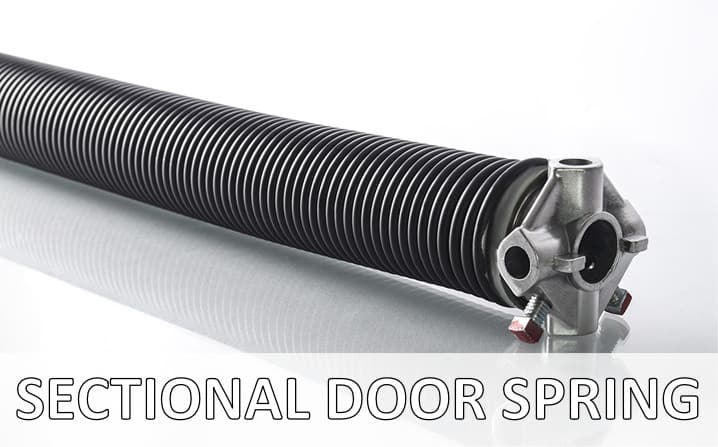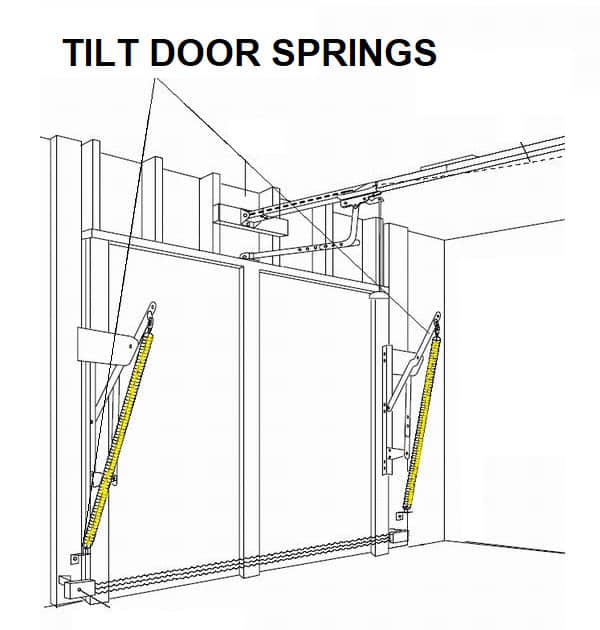
GARAGE DOOR SPRINGS
There are only two reasons you would happen to come across this page all about garage door springs:
1. You’re a garage door technician who knows exactly what a garage door spring is, or…
2. You are the owner of a garage door and there is an issue with your door’s spring.
If you’re the technician and you’re wanting to purchase replacement springs, visit our online shop.
If you’re the owner of a garage door and there is an issue with the spring: Don’t attempt to open or close your garage door! Doing so will likely result in further damage, resulting in a costly repair.
Instead, keep reading to find out the best way to go about addressing the garage door spring – unfortunately, it will likely require the attention of a garage door technician.
WHAT ARE GARAGE DOOR SPRINGS?
Garage door springs are probably the largest spring the average home-owner will ever encounter. These springs are an integral part of the garage door set up. When broken, the garage door cannot be used!


Garage door springs are used to ‘reduce’ the weight of the garage door by pulling the door in the direction of the motor. The springs do not pull with enough force to open the door but they do take the strain of most of the door’s weight.
Garage door motors are not powerful enough to lift the entire weight of a garage door – a standard double-garage door can weigh over 100kgs – but, when most of the door’s weight is taken by the tension of the spring, the motor is powerful enough to move the remainder of the door’s ‘effective weight’.
If you have ever tried to raise a garage door by hand, you will notice that raising it does not feel like you’re lifting over 100kgs of steel, it will feel much, much lighter.
The door feels so light because of the spring which is bearing most of the door’s weight.
When a garage door is correctly ‘sprung up’ (the springs are installed and tensioned to take the ideal amount of weight), the garage door spring will take roughly 80% of the weight of the door.
Unfortunately, it is not uncommon for springs to break after a number of years and it is very important that a homeowner can identify when the garage door’s spring has snapped.
WHAT HAPPENS WHEN THE SPRING BREAKS?
When a garage door spring breaks, the tension of the spring is released suddenly and violently. It will make an incredibly loud bang – see the video below to hear the spring break!
If someone is home, this bang will be very difficult to miss. Unfortunately, as most people don’t know about garage door springs it can be difficult for the average homeowner to identify where exactly the loud bang came from – and if no one was home when the spring snapped, they would have absolutely no idea the spring is broken!
This is a big problem! As explained earlier, a garage door motor is only designed to lift 20% of the door’s weight. When the spring is broken, and the user attempts to open the door with the motor, the motor will be required to take the full ~100kg weight of the door. This is far too heavy a weight for the motor to handle. The motor will not be able to lift the door and will burn out the engine in its attempt to do so.
This can be a very costly error as a burnt out motor cannot be repaired, and a replacement motor can cost anywhere from $400 to $1,400 – depending upon the make and model of the motor.

HOW CAN I TELL IF MY GARAGE DOOR’S SPRING IS BROKEN?
The main way to tell if your garage door’s spring is broken is to look at the spring from the inside of the garage.
Sectional garage door springs sit above the door and run parallel to the door’s panels. Tilt door springs sit on either side of the door, stretching from the bottom corners up to the door’s hinge arms.



WHAT TO DO WHEN THE DOOR’S SPRING IS BROKEN?
When a garage door’s spring breaks you should:
Leave the garage door exactly as it is – do not attempt to open or close the door.
If the door remains open, ensure that nothing passes beneath the door.
Call your local garage door company or technician to attend to your garage door.
The technician will close the door – ensure that it is safe – then install and tension the new springs.
Most garage door springs break when the garage door is opening.
When the spring breaks, the door will become too heavy for the garage door motor to lift, and the door will fall back to the floor with great speed and force. Hopefully, nothing is in the way when this occurs, else it will be crushed by the door.
Leave the garage door closed – this is the safest position that the door can be in while the garage door spring is broken – and do not attempt to open it! With the spring broken, the door will be incredibly heavy and can come crashing down on you or your feet and toes if dropped. It’s safest to simply leave it as is until a garage door technician can attend the property and replace the broken spring.
If the garage door remains open it is best to leave the door exactly as it is. Do not touch the door or attempt to close it. Leave the closing of the door to the garage door technician.
Without the garage door spring intact the door is no longer being pulled upwards and held open. The door will be sitting in a precarious position where slight pressure on the door could bring it crashing down. Given the risk, it is incredibly important not to allow anyone or anything to pass beneath the garage door.
HOW TO PREVENT YOUR GARAGE DOOR SPRING FROM BREAKING?
To ensure that the spring does not deteriorate and potentially snap, you should do three things:
1. Regularly service your garage door
Regularly servicing will ensure that the garage door set up is working as it should and ensure that the various parts are inspected, lubricated, repaired, or replaced where necessary. It is recommended that you service your garage door roughly every 12 – 18 months.
2. Perform a visual inspection of the springs
A visual inspection will give you an indication of the spring’s condition. Unsurprisingly, rusty springs are prone to deterioration and breakage and will do so much quicker than well-lubricated springs.
3. Regularly check to ensure the garage door spring is correctly tensioned
Checking to the spring’s tension will ensure the correct amount of weight is borne by the spring; that the motor is not having to strain excessively; and that the spring does not weaken as a result of being over-tensioned.
HOW TO TEST THE GARAGE DOOR SPRING TENSION?
Follow these to test the tension of your garage door spring:
Close your garage door
Disengage the garage door from the motor – or, in other words, ‘put the door into manual mode’
Lift the garage door until the bottom of the door is roughly chest height
Step back from the garage door (to remove your feet from the opening, should the door come down)
Let go of the garage door
A correctly tensioned garage door spring should hold the garage door in that position – the door should not go up or down.
If the door drops, as if to close, this is a clear sign that the garage door spring is under-tensioned. This is a common condition. If the door goes up, as if to open, this is a clear sign that the garage door spring is over-tensioned. This rarely occurs.
The spring will need to be re-sprung accordingly.
CAN YOU RE-TENSION A GARAGE DOOR SPRING YOURSELF?
The process of re-tensioning the spring can be quite dangerous if performed by someone other than a trained garage door technician. This is because the springs are tensioned as to be able to bear roughly 80% of the garage door’s weight. To do so, a lot of elastic power is stored within the tension of these springs! If that power was to be released all at once, it could cause serious injury.
For this reason, we never recommend the springs are re-tensioned by anyone other than a garage door technician (who has been trained specifically to do this in a safe manner).


